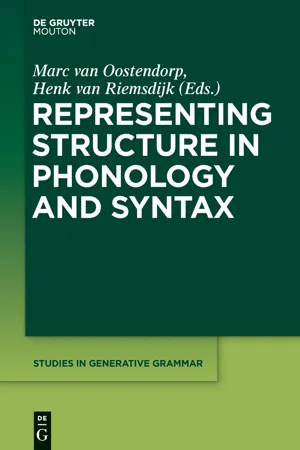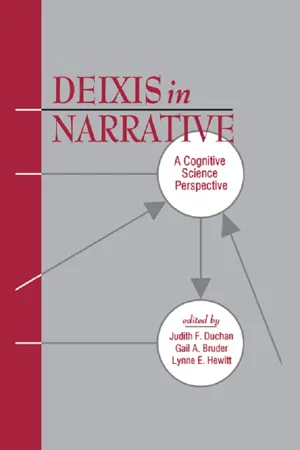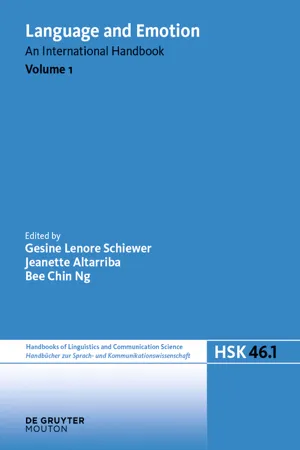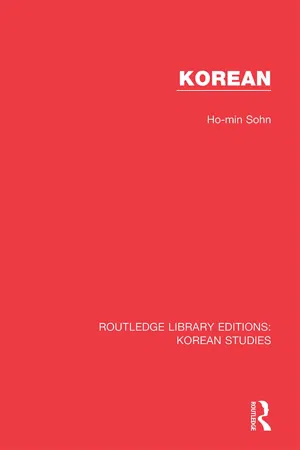Languages & Linguistics
Interjections
Interjections are words or phrases used to express strong emotions or feelings in a spontaneous manner. They often stand alone or are inserted into sentences to convey surprise, joy, pain, or other sentiments. In linguistics, interjections are considered a distinct part of speech and are not grammatically connected to the rest of the sentence.
Written by Perlego with AI-assistance
5 Key excerpts on "Interjections"
- eBook - ePub
- Marc van Oostendorp, Henk van Riemsdijk, Marc van Oostendorp, Henk van Riemsdijk(Authors)
- 2015(Publication Date)
- De Gruyter Mouton(Publisher)
pf /; meaning: irony) display sequences of phonemes (here represented in boldface) that are not attested in other parts of speech in Dutch, such as nouns, verbs and adjectives. In other words, Interjections have their own phonotactic properties.In spite of this linguistically isolate behavior, it seems that Interjections are nevertheless linguistically significant and worthwhile to investigate for a number of reasons.37 First of all, the language learning child is able to identify Interjections as language material in the noise that she hears in her environment. In other words, just like the sound sequences cow , couch and loops are identified as linguistically meaningful units, so are the Interjections wow!, ouch! , and oops! . In short, Interjections are acquired during language development and become part of our knowledge of language. If it is the linguist’s task to describe and explain our knowlegde of language (see Chomsky 1986 ), then Interjections should also be part of that research agenda. Secondly, Interjections are a part of speech that can be found cross-linguistically (De Groot 1963). In other words, it seems to be a universal part of speech. Thirdly, Interjections may give us a mirror of a part of the mind that we are less familiar with, viz., our emotion system. Certain Interjections highlight the affective or emotional state of a speaker. They constitute what Scherer (1994 : 170) calls affect bursts , that is “very brief, discrete, nonverbal expressions of affect in both face and voice as triggered by clearly identifiable events.”38 These linguistic affect bursts differ from expressive signals in animal communication systems in an important way: they are innovative and free from control by external stimuli. One and the same emotion-eliciting event may trigger the use of different but yet appropriate Interjections. For example, if you hit with a hammer on your thumb, you may express your negative feelings by using different Interjections: e.g., Darn!/Ouch!/Gee!/Argh! - eBook - ePub
Deixis in Narrative
A Cognitive Science Perspective
- Judith F. Duchan, Gail A. Bruder, Lynne E. Hewitt, Judith F. Duchan, Gail A. Bruder, Lynne E. Hewitt(Authors)
- 2012(Publication Date)
- Psychology Press(Publisher)
They are lexemes and utterances; they have to be described semantically and pragmatically; they require “the examination of our relation to social situations at large, not merely our relation to conversation” (Goffman, 1981, p. 90). As utterances they are verbless and nounless, so we must be concerned about their relation to sentences and what their position is with respect to the grammatical component. Their relation to other areas of the lexicon must be investigated not only synchronically, but also through a study of their diachronic development. They need not only be declarative forms, but they may be interrogative, imperative, or exclamative—both in their intonation pattern and in the speech acts they convey. They are not only associated with the strictly linguistic component, but also with nonlinguistic, gestural means of communication. Formal syntactic approaches are not in a position to handle them, nor are formal semantic approaches. Similarly, radical semantic and radical pragmatic approaches fall short. Interjections point to the inadequacies of received wisdom, and so it has been easier to dismiss them than it has been to accommodate them. However, as Goffman (1981, p. 12) noted with respect to response cries, imprecations, and self talk, “these utterances are too commonly met with in daily life, surely, to justify scholarly neglect.” This chapter attempted to grapple with some of the difficult linguistic issues which Interjections raise, and to demonstrate why Interjections merit serious linguistic investigation. Müller’s enlightened quote from 1862 provides an appropriate conclusion: One short interjection may be more powerful, more to the point, more eloquent than a long speech. (Müller, 1862, p. 368) Epilogue It is now possible to discuss some aspects of how the previous account of Interjections relates to narrative concerns - eBook - ePub
- Gesine Lenore Schiewer, Jeanette Altarriba, Bee Chin Ng, Gesine Lenore Schiewer, Jeanette Altarriba, Bee Chin Ng(Authors)
- 2022(Publication Date)
- De Gruyter Mouton(Publisher)
Kockelman 2003 ). Heritage (1984) contends that in many languages some Interjections are devoted to convey change in epistemic state. More generally, Poggi (1981) and Caron-Pargue and Caron (2000) point out an important function of Interjections: to display the Speaker’s current cognitive functioning.Studies and taxonomies of Interjections have been proposed for Italian (Poggi 1981 ), German (Ehlich 1986 ; Graf 2010 ), French (Zerling 1995 ; Kleiber 2006 ), Russian (Šaronov 2008), Q’eqchi’ Maya (Kockelman 2003 ), English (Ameka 1992a ; Wierzbicka 1992 , 2003; Jovanovič 2004; Goddard 2014 ). Some of these taxonomies mainly focus on the emotional meaning of Interjections (e.g., Jovanovič 2004), while others strongly stress their social, discursive and situational functions. Also, semantic analyses of single Interjections have been carried out (Spitzer 1922 ; Nencioni 1977 ; Goffman 1981 ; Poggi 1981 ; Heritage 1984 ; Norrick 2008 ; Golato 2010 ; Goddard 2014 ; Koivisto 2015 ; Weidner 2016 ; Garcìa-Ramòn 2018; Endo 2018 ; Vazquez Carranza 2016; Polanco Martinez 2018; Pauletto, Ursi, and Ericsdotter Nordgrén, forthcoming), witnessing their rich and sophisticated semantics.3 Interjection: a holophrastic word
As seen from previous literature, the main issues tackled in the domain of Interjections highlight some peculiarities of this part of speech: (a) its relative syntactic independence from other words or even sentences in discourse; (b) its being a “primitive” kind of communicative signal, and (c) its emotional content. But the feature that most characterizes the interjection is the fact (Poggi 1981 ; Huddleston and Pullum 2002 - CHAPTER 4. IDEOPHONES AND InterjectionsThe so-called expressives in language include ideophones and Interjections as subclasses. Ideophones are usually defined as those words which display phonological symbolism of acoustic, articulatory, or structural kind and have some distinct morpho-syntactic properties. Interjections are understood as ejaculatory words including exclamations, cries, calls, or inarticulate utterances expressing emotion, which are typically forms of speech lacking grammatical connection with other sentential elements. Such expressions abound in Korean.4.1. IdeophonesIdeophones (sound symbolic or onomatopoeic expressions) in Korean, which are estimated at four thousand odd items, constitute a very productive and pervasive class in the lexicon of Korean.1 Most of these ideophonic expressions appear in native words, and rarely in Sino-Korean or loan words.To judge whether a word in Korean is ideophonic or not may be made, by and large, by native intuition. This is particularly the case with phonomimes. On the other hand, there are many cases, especially with phenomimes, where native intuition diverges. It is for this reason that phonological, morphological, syntactic, and semantic considerations need to be introduced to determine the ideophonic status of words in a systematic way.2 As a rule, ideophonic expressions include: words with clear sound symbolism; two or more words that share the same denotative meaning but show vowel or consonant gradation with connotational variation; words which are subject to the general structural properties of ideophones, such as vowel harmonic alternation, reduplication, use as an adverb, and collocation with the verbal hata ‘do, be’ and/or the verbalizer suffix -kelita
- eBook - ePub
- Edward Burnett Tylor(Author)
- 2016(Publication Date)
- Dover Publications(Publisher)
The Green-landera, he says, especially the women, accompany many words with mien and glances, and he who does not well apprehend this may easily miss the sense. Thus when they affirm anything with pleasure they suck down air by the throat with a certain sound, and when they deny anything with contempt or horror, they turn up the nose and give a slight sound through it. And when they are out of humour, one must understand more from their gestures than their words. 22 Interjection and gesture combine to form a tolerable practical means of intercourse, as where the communication between French and English troops in the Crimea is described as “consisting largely of such interjectional utterances, reiterated with expressive emphasis and considerable gesticulation.” 23 This description well brings before us in actual life a system of effective human intercourse, in which there has not yet arisen the use of those articulate sounds carrying their meaning by tradition, which are the inherited words of the dictionary. When, however, we look closely into these inherited sense-words themselves, we find that interjectional sounds have actually had more or less share in their formation. Not stopping short at the function ascribed to them by grammarians, of standing here and there outside a logical sentence, the Interjections have also served as radical sounds out of which verbs, substantives, and other parts of speech have been shaped. In tracing the progress of Interjections upward into fully developed language, we begin with sounds merely expressing the speaker’s actual feelings. When, however, expressive sounds like ah ! ugh! pooh! are uttered not to exhibit the speaker’s actual feelings at the moment, but only in order to suggest to another the thought of admiration or disgust, then such Interjections have little or nothing to distinguish them from fully formed words. The next step is to trace the taking up of such sounds into the regular forms of ordinary grammar
Index pages curate the most relevant extracts from our library of academic textbooks. They’ve been created using an in-house natural language model (NLM), each adding context and meaning to key research topics.
Explore more topic indexes
Explore more topic indexes
1 of 6
Explore more topic indexes
1 of 4




